A drum dryer has a hollow drum that spins. Steam heats the drum. A thin layer of liquid, paste, or powder goes on the drum’s surface. The heat removes water fast. This turns the product into a dry film or powder. Drum dryers remove moisture well. They also protect materials that cannot handle much heat. These machines are important in food, chemical, and pharmaceutical industries.
The worldwide market for industrial dryers was $6.10 billion in 2024. Food processing and pharmaceuticals are the main areas using them.
Application | Typical Materials |
|---|---|
Food Processing | Starches, purees |
Pharmaceuticals | Extracts, suspensions |
Chemicals | Slurries, adhesives |
Key Takeaways
Drum dryers have a spinning hot drum. They dry sticky, thick, or heat-sensitive stuff fast and evenly.
There are different drum dryers like single, double, vacuum, and rotary. These types work for many products and industries. They are used in food, medicine, and chemical factories.
Drum dryers use less energy and cost less to run than many other dryers. They also keep the product quality high.
Doing regular check-ups and watching speed, heat, and load size helps drying. This also makes the machine last longer.
Drum dryers help companies dry things safely. They lower pollution and can dry things that other dryers cannot handle well.
How Drum Dryers Work?
Drum dryers utilize a rotating drum to dehydrate and dry materials. The process involves feeding a slurry or moist material into the drum, where it is evenly distributed and exposed to a heated air stream, resulting in rapid moisture evaporation.
Operating Principle
A drum dryer dries things in a simple way. The process has a few main steps. First, the operator puts a liquid or slurry on the spinning drum. The product spreads into a thin layer on the hot drum. Steam or another heat source heats the inside of the drum. The heat moves through the drum wall. This makes water in the product turn into vapor fast. The operator can change the drying temperature by adjusting steam pressure. This keeps the drying steady. The drum spins at the same speed all the time. This helps the product dry quickly and evenly. Drying often takes only a few seconds. A scraper or knife takes the dry product off the drum. Fans and hoods remove vapor and protect heat-sensitive materials.
Tip: The operator should watch drum speed and load size. Faster drum speeds and bigger loads help dry things more evenly. They also save energy. For small loads, medium drum speeds work best.
Studies show that drum speed and load size matter. Bigger loads dry better at faster drum speeds. Small loads need medium speeds for the best results. By controlling speed and load, drum dryers work better than many other dryers.
Key Components
A drum dryer has many important parts. Each part helps with drying.
Drum: The drum is a big, spinning cylinder. It gives a surface for drying. It also tumbles the material for even heat.
Heating System: This part gives the heat to dry the product. Most use steam, but some use gas or electricity.
Feeding System: This system controls how much product goes into the drum. It uses things like screw or belt feeders to spread the product.
Discharge System: This part takes the dry product out of the drum. It can use gravity or an auger to move the material.
Ventilation System: Fans and air inlets take away wet air. They bring in fresh air. This helps drying and keeps the temperature steady.
Control System: Sensors and controllers manage temperature, drum speed, and airflow. Many use programmable logic controllers (PLCs) for good control.
Insulation: Insulation covers the drum and hot parts. It keeps heat inside and saves energy.
All these parts work together. They make the drum dryer a good and dependable machine for drying many materials.
What Are the Different Types of Drum Dryers?
Drum dryers come in several types, including single-drum, double-drum, and twin-drum dryers. Each type is designed to meet specific drying requirements in various industrial processes.
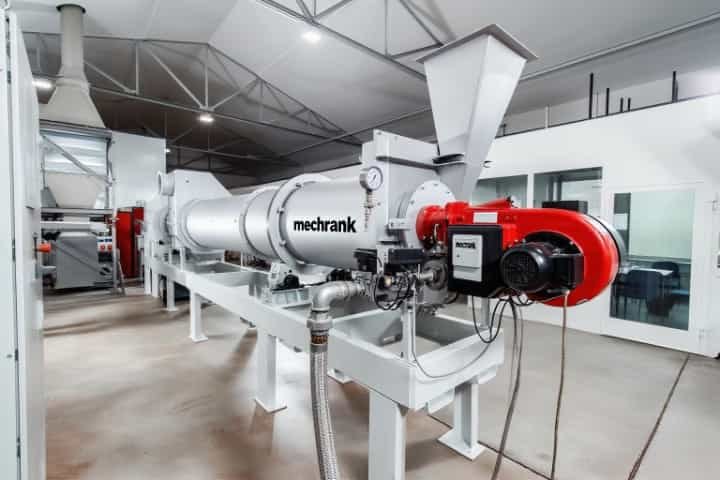
Single Drum
A single drum dryer has one big heated drum. The product spreads in a thin layer on the drum. Steam or another heat source heats the drum from inside. The drum spins and dries the product fast. A scraper takes off the dry layer. This makes flakes or powder.
Key features:
It makes dried products that do not clump.
Cleaning and fixing it is simple.
It works for grains, seeds, powders, and pastes.
Typical applications:
Food and dairy: milk powder, tomato puree, fruit pulps, baby food, sauces, jams.
Chemical and pharmaceutical: drying pastes and slurries.
Note: Single drum dryers are good for small businesses. They work well for continuous jobs. They handle sticky and heat-sensitive materials.
Typical Applications | |
|---|---|
Even drying and high heat efficiency | Milk powder, fruit pulps, baby food |
Settings can change for different products | Chemical pastes, slurries |
Small and easy to fix | Grains, seeds, powders |
Double Drum
Double drum dryers have two heated drums side by side. The drums spin toward each other. The product goes between the drums in a thin film. The drums dry the product as they turn. A scraper removes the dry material.
Advantages:
The dried product has good pores for rehydration.
They are clean and easy to use.
They are good for small batches.
Typical applications:
Thick foods: mashed potatoes, baby cereal flakes, pregelatinized starches, fruit or vegetable pulps.
Chemical and pharmaceutical: drying thick pastes and gels.
Aspect | Description |
|---|---|
How it works | Thin layer goes between two hot drums; dries and is scraped off. |
Feed rate, drum speed, steam pressure, and drum gap. | |
Good for | Pastes, gelatinized starches, baby foods, pulps. |
Product examples | Mashed potato flakes, baby cereal flakes. |
Tip: Operators should balance steam, drum speed, and feed rate.
Vacuum Drum
Vacuum drum dryers work in a sealed chamber with low pressure. The vacuum makes water boil at a lower temperature. The product spreads in a thin film on the hot drum. It dries fast at lower heat. A scraper takes off the dry product.
Benefits:
Short time on the hot drum.
Less chance of heat damage.
Typical applications:
Pharmaceuticals: drying active ingredients and amorphous solid dispersions.
Food: milk powder, pregelatinized starch, tomato puree.
Note: Vacuum drum dryers use more energy than others. But they protect sensitive products and help them last longer.
Rotary Drum
Rotary drum dryers use a big spinning cylinder. The drum tilts so material moves from one end to the other. Hot air or gas flows through the drum. The material tumbles and mixes as it dries.
Key features:
Strong design for long use.
Handles lots of material and many types.
Can use direct or indirect heat.
Inside flights lift and drop material for better drying.
Industries using rotary drum dryers:
Fertilizers, animal feeds, minerals, ores, aggregates, chemicals, paper pulp, sludge, salts, sugars, sand.
Characteristic/Feature | Description/Details |
|---|---|
Design | Big spinning drum, strong build |
How it works | Material is lifted inside; runs at 200°F to 2200°F |
Types | Direct (material touches hot gases) and Indirect (heat through drum shell) |
Capacity | 1 to 200 tons per hour |
Industries | Fertilizers, minerals, chemicals, food, paper, aggregates |
Rotary drum dryers are used for drying large amounts of solids. They are reliable and can dry sticky materials.
In-Drum
In-drum dryers, also called drum dryers or rotary dryers, use a spinning drum to dry things. The drum lets wet material touch hot air or gas. The spinning lifts and tumbles the material. This helps it dry faster.
Key features:
Can use gas, oil, or electricity for heat.
Dries powders, granules, sticky or pasty stuff.
Works for co-current or counter-current drying.
Primary uses:
Food: drying fruits, vegetables, dairy, grains, potato flakes, cereals, baby food.
Chemicals: pigments, resins, detergents, fertilizers.
Pharmaceuticals: antibiotics, vitamins, herbal extracts, APIs.
Tip: Pick the right in-drum dryer for your material. Operators can change drum speed, flight shape, and air flow for best drying.
What Are the Applications of Drum Dryer?
Drum dryers are widely used in the food, chemical, and pharmaceutical industries for drying slurry or liquid materials into flakes, powders, or granules. These dryers offer efficient heat transfer and rapid drying capabilities.
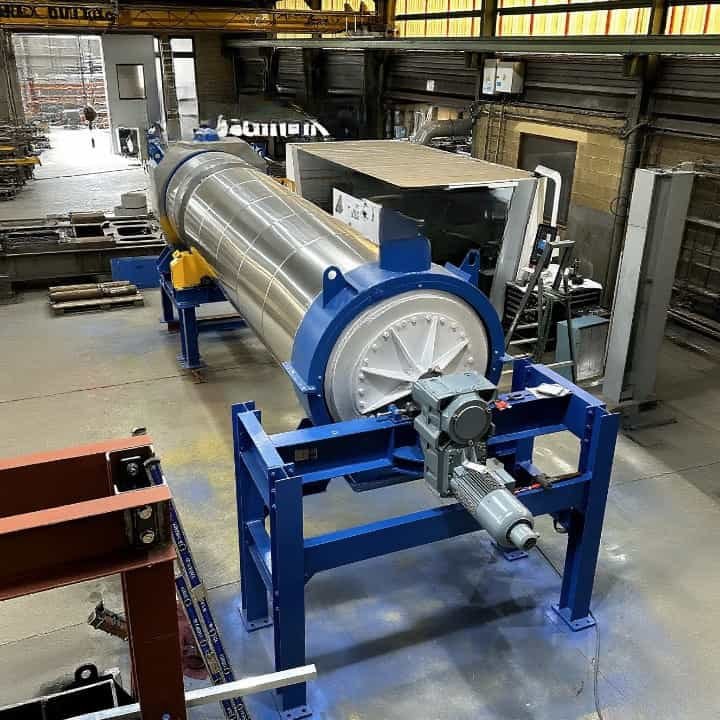
Food Industry
Drum dryers are very important in food processing. They dry many foods fast and evenly. Companies use them to make powders or flakes from wet foods. Some foods made this way are:
Coffee, tea, and powdered drinks
Cereal foods and cereal flakes
Potatoes and starch products like instant mashed potatoes
Sugar beet pulp
Fruit and vegetable purees for soups, baby foods, and snacks
Drum drying is good for foods that need a special feel. It also works when spray drying does not. Mashed potatoes turn light and fluffy. Fruit leathers stay chewy. Studies show changing drum speed and steam pressure helps control moisture and color. This makes the products high quality.
Chemical and Pharmaceutical
Chemical and pharmaceutical companies use drum dryers for many materials. These dryers work well for liquids, slurries, and things that cannot take much heat. The table below shows some common uses:
Dryer Type | Common Materials Dried | Advantages |
|---|---|---|
Pharmaceuticals, specialty chemicals, polymers, fertilizers | Large capacity, easy operation | |
Liquid phase materials, chemical slurries | Good for liquids, continuous use | |
Thin-Film Dryer | Pharmaceuticals, specialty chemicals | Low energy, gentle drying |
Pharmaceutical companies must follow strict safety and quality rules. Drum dryers help meet these rules by drying products safely.
Environmental and Other Uses
Drum dryers help with pollution and waste control. They dry things like sludge, waste, and other environmental products. Their design lets them handle different types of materials. Some companies use drum dryers to shrink waste and make it easier to throw away. New studies show that better drum dryer settings can save almost half the energy. They can also cut carbon emissions by over 70% compared to old ways.
Tip: Using sealed or condenser drum dryers can help stop air pollution from microfibers.
Drum Dryer Applications
Drum dryers are best for sticky, thick, or heat-sensitive materials. They dry things that other dryers cannot handle well. Some examples are:
Starches and instant flours
Adhesives and resins
Herbal extracts and vitamins
Sludges and waste from water treatment
Drum dryers save energy and dry things well. They also help keep nutrients or active parts in the final product.
What Are the Advantages and Disadvantages of Drum Dryer?
Drum dryers offer efficient drying for various materials through a rotating drum, ensuring uniform heat distribution. However, they come with high energy consumption and maintenance requirements.
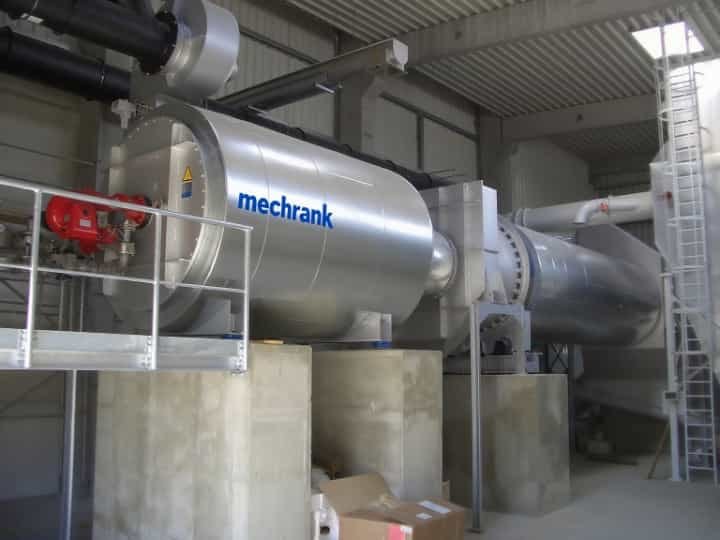
Benefits
A Drum Dryer has many good points for drying things in factories. People who use it say it is simple and easy to run. The machine dries a thin layer of stuff on a hot drum. Then, it scrapes off the dry flakes. This way works well for sticky or thick foods that other dryers cannot dry. Many food companies like drum dryers because they keep the taste, color, and nutrients in the food.
Drum dryers use less energy than most other dryers. They can be up to 80% efficient, so they save money.
These machines cost less to buy and use than spray dryers.
Drum dryers make flakes that mix with water easily, so they are good for instant foods.
The machines are made from strong things like cast iron and chrome. This means they last a long time and are easy to clean.
They are also clean to use, so there is less chance of germs.
The table below shows how changing drum dryer settings can help save energy and money:
Metric | Improvement (%) | Description |
|---|---|---|
Energy Consumption | Less energy used with better settings | |
Specific Moisture Extraction Rate | 55.4 | Faster and more efficient drying |
Carbon Emissions | 70.9 | Lower emissions help the environment |
Monetary Utility Cost | 77.9 | Big savings on operating costs |
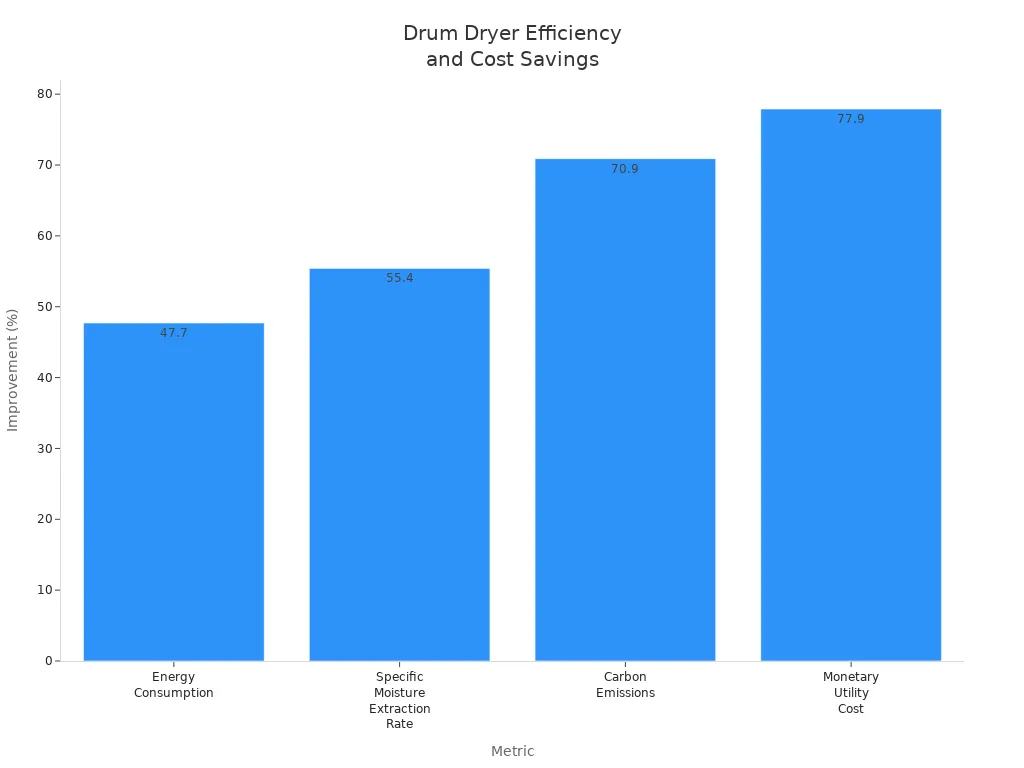
Tip: Drum dryers are best for thick or sticky foods that need to dry fast and evenly.
Limitations
Drum dryers also have some problems. People must check and fix the machine often. Bearings need oil, and old parts should be changed quickly. If the drum is empty or does not spin, it can bend or sag. This can be expensive to fix.
Sometimes, drying is not even, especially with foods that have different parts like leaves and stems.
If the dryer gets too hot, it can burn or hurt foods that are easy to damage. For example, red peppers can lose color and nutrients if dried at high heat.
The machine needs careful control of heat, air, and speed to keep food good.
There are safety risks like fire, so people must use safety tools like pressure relief and fire systems.
Operational Issue | Description and Concerns |
|---|---|
Fire can happen; safety tools and careful watching are needed | |
Abrasion and Corrosion | Parts can wear out; strong materials and the right speed help |
Product Quality | Uneven drying or burning can make food worse; careful control is important |
Maintenance | Checking and fixing the machine often keeps it working well |
Note: Checking the machine often and good training can stop most problems with drum dryers.
What Are the Practical Considerations Before Implementation?
Before implementing any project, it’s crucial to evaluate resources, assess risks, and define clear objectives to ensure success. Assessing these factors helps in making informed decisions and avoiding potential pitfalls.
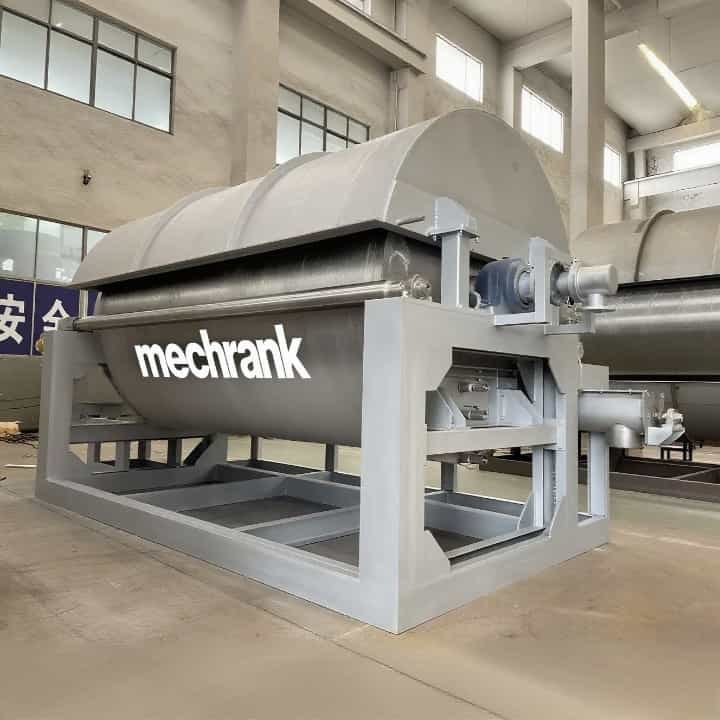
Maintenance
Doing regular maintenance helps the drum dryer work well. Operators should look at the drum surface for cracks or stuff stuck on it. They need to clean the drum after every batch so nothing sticks. Oiling the bearings and moving parts stops them from breaking. Technicians should check seals and gaskets to see if they leak. They must change old scrapers to keep drying even. A simple checklist helps teams remember what to do: – Look for cracks or buildup on the drum – Clean the drum and feeding system after each use – Oil the bearings and moving parts every week – Check seals and gaskets for leaks – Change scrapers when they get old
Tip: Writing down repairs in a log helps find problems early.
Product Suitability
Not all materials dry well in a drum dryer. Operators should test the product before drying a lot. Sticky, thick, or heat-sensitive things dry best. Thin liquids may not make a good film. Big pieces can fall off the drum. The table below shows which products work well:
Product Type | Suitability |
|---|---|
Sticky pastes | Excellent |
Thick slurries | Very Good |
Heat-sensitive items | Good |
Thin liquids | Poor |
Large particles | Not Suitable |
Testing a small batch first can save time and money.
Operation Tips
Operators can get better results by changing settings. They should set drum speed to match how thick the product is. Slow speeds work for thick pastes. Fast speeds help thin layers dry quickly. Changing steam pressure changes the drying temperature. Using the right scraper angle helps remove dried product. Operators should watch for uneven drying or burning.
Note: Training workers on safe use and emergency stops keeps everyone safe with a drum dryer.
A Drum Dryer can dry liquids, pastes, and powders fast. There are different types for many jobs in food, chemicals, and waste. People who work with petrochemicals trust drum dryers because they work well and can do many things.
Louisville Dryers have helped factories for more than 130 years. They are known for being strong and lasting a long time.
The rotary drum dryers market is getting bigger. It may reach $1.8 billion by 2033.
People should look at what care the dryer needs and pick the right one for their product. Drum dryers are still very important in today’s factories.
FAQ
What materials work best in a drum dryer?
Drum dryers work best with sticky pastes and thick slurries. They also dry heat-sensitive items well. Thin liquids do not dry as well. Large particles are not a good fit. Operators should test new materials before drying a lot.
How does a drum dryer save energy?
A drum dryer dries things by touching the hot drum. This dries materials fast and uses less energy. Other dryers often use more energy. Operators can change settings to make it work better.
Can a drum dryer handle food products safely?
Yes, drum dryers can dry food safely. Food-grade drum dryers use stainless steel parts. These are easy to clean. Cleaning and maintenance stop germs from spreading. Many companies use them for milk powder, fruit purees, and cereals.
What maintenance does a drum dryer need?
Operators should clean the drum after every use. They need to check for buildup and oil moving parts each week. Seals must be checked and scrapers replaced if worn. Keeping a log helps find and fix problems early.
Why choose a drum dryer over other dryers?
Drum dryers dry sticky, thick, or heat-sensitive things better than most dryers. They work quickly and save energy. They also cost less to run. Many industries pick drum dryers for these reasons.

